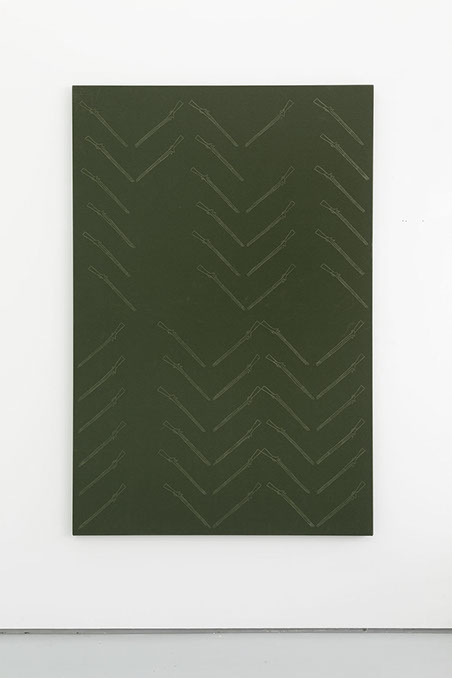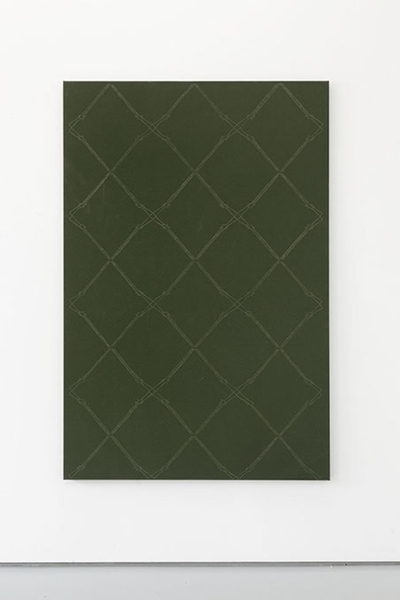"Muraskin"Steaphan Paton

TRISTIAN KOENIG
19 GLASSHOUSE ROAD, COLLINGWOOD, VICTORIA, AUSTRALIA 3066Telephone : +61 498 694715 email
APRIL 27th > JUNE 10th, 2017
 Steaphan Paton | Muraskin | 2017 | Installation view | |

 | |
| Etched colonial cotton canvas | 180 x 120 cm | |
Tristian Koenig is pleased the announce the opening of Muraskin - a solo exhibition of new works by Melbourne-based Steaphan Paton. A member of the Gunai and Monero Nations, Paton works from a unique post-conceptual position, which combines traditional First Nations cultural practices, and historical and archival research, with (auto)biography and more broadly the experience of contemporary indigeneity in Australia.
The colonial settlement and squatting on Gunai land in South-Eastern Victoria was a site of intense resistance and contestation by the local Gunai clans as noted by Gippsland squatter Henry Meyrick in 1864:
The blacks are very quiet here now, poor wretches. No wild beast of the forest was ever hunted down with such unsparing perseverance as they are. Men, women and children are shot whenever they can be met with … I have protested against it at every station I have been in Gippsland, in the strongest language, but these things are kept very secret as the penalty would certainly be hanging … For myself, if I caught a black actually killing my sheep, I would shoot him with as little remorse as I would a wild dog, but no consideration on earth would induce me to ride into a camp and fire on them indiscriminately, as is the custom whenever the smoke is seen. They [the Aborigines] will very shortly be extinct. It is impossible to say how many have been shot, but I am convinced that not less than 500 have been murdered altogether *
Using the image of a colonial musket - muraskin in the Gunai language, as his starting point, Paton’s appropriates and converts this symbol into a sign of indigenous defiance via the creation of traditional geometric designs with the muraskin as their basis. Paton uses this ‘rule’ as a formal trope in the generation of works that mimics the strategies for first generation conceptual practice.
As a conceptual counterpoint, Paton's renders the muraskin through etching the surface of ‘colonial cotton canvas’ - a type of durable canvas used for squatters tents, and more recently by recreational users of Guani lands, such as campers, hunters and grey-nomads. The green canvas evokes the quasi-militaristic nature of the colonial, and the ongoing occupation of Gunai lands.
Steaphan Paton (b. Mildura, 1985) is a member of the Gunai/Moreno Nations. Paton completed an MFA from the Victorian College of the Arts, University of Melbourne, Melbourne (2016), Archeological Field School, Flinders University, Adelaide (2009) and a Bachelor of Environmental Science, Deakin University, Melbourne (2007). Recent exhibitions include Sovereignty, Australian Centre for Contemporary Art, Melbourne (2016); 33rd Telstra National ATSI Art Awards, Museum and Art Gallery of Northern Territory, Darwin (2016); Re-visioning Histories, Bundoora Homestead, Bundoora (2016); Ngujarn and Nakun: Belonging in the Other, Koorie Heritage Trust, Melbourne (2016) Primavera, Museum of Contemporary Art, Sydney (2015) and Murruwaygu, Art Gallery of New South Wales, Sydney (2015). Paton’s work is held in the collection of the National Gallery of Australia, Canberra; National Gallery of Victoria, Melbourne; Melbourne Museum, Melbourne; Brooklyn Art Library, New York, United States; Wellington Shire Council, Sale; City of Yarra, Melbourne; City of Darebin, Melbourne; Deep Space, Melbourne, and private collections in Australia, United States and Europe.
*Henry Meyrick quoted in Morgan, Patrick. Gippsland Settlers and the Kurnai Dead, Quadrant, Vol. 48, No. 10, October, 2004. pp. 26-28
To preview works in the exhibition click here
The colonial settlement and squatting on Gunai land in South-Eastern Victoria was a site of intense resistance and contestation by the local Gunai clans as noted by Gippsland squatter Henry Meyrick in 1864:
The blacks are very quiet here now, poor wretches. No wild beast of the forest was ever hunted down with such unsparing perseverance as they are. Men, women and children are shot whenever they can be met with … I have protested against it at every station I have been in Gippsland, in the strongest language, but these things are kept very secret as the penalty would certainly be hanging … For myself, if I caught a black actually killing my sheep, I would shoot him with as little remorse as I would a wild dog, but no consideration on earth would induce me to ride into a camp and fire on them indiscriminately, as is the custom whenever the smoke is seen. They [the Aborigines] will very shortly be extinct. It is impossible to say how many have been shot, but I am convinced that not less than 500 have been murdered altogether *
Using the image of a colonial musket - muraskin in the Gunai language, as his starting point, Paton’s appropriates and converts this symbol into a sign of indigenous defiance via the creation of traditional geometric designs with the muraskin as their basis. Paton uses this ‘rule’ as a formal trope in the generation of works that mimics the strategies for first generation conceptual practice.
As a conceptual counterpoint, Paton's renders the muraskin through etching the surface of ‘colonial cotton canvas’ - a type of durable canvas used for squatters tents, and more recently by recreational users of Guani lands, such as campers, hunters and grey-nomads. The green canvas evokes the quasi-militaristic nature of the colonial, and the ongoing occupation of Gunai lands.
Steaphan Paton (b. Mildura, 1985) is a member of the Gunai/Moreno Nations. Paton completed an MFA from the Victorian College of the Arts, University of Melbourne, Melbourne (2016), Archeological Field School, Flinders University, Adelaide (2009) and a Bachelor of Environmental Science, Deakin University, Melbourne (2007). Recent exhibitions include Sovereignty, Australian Centre for Contemporary Art, Melbourne (2016); 33rd Telstra National ATSI Art Awards, Museum and Art Gallery of Northern Territory, Darwin (2016); Re-visioning Histories, Bundoora Homestead, Bundoora (2016); Ngujarn and Nakun: Belonging in the Other, Koorie Heritage Trust, Melbourne (2016) Primavera, Museum of Contemporary Art, Sydney (2015) and Murruwaygu, Art Gallery of New South Wales, Sydney (2015). Paton’s work is held in the collection of the National Gallery of Australia, Canberra; National Gallery of Victoria, Melbourne; Melbourne Museum, Melbourne; Brooklyn Art Library, New York, United States; Wellington Shire Council, Sale; City of Yarra, Melbourne; City of Darebin, Melbourne; Deep Space, Melbourne, and private collections in Australia, United States and Europe.
*Henry Meyrick quoted in Morgan, Patrick. Gippsland Settlers and the Kurnai Dead, Quadrant, Vol. 48, No. 10, October, 2004. pp. 26-28
To preview works in the exhibition click here


OPENING:
FRIDAY 28th APRIL (6-8pm)







